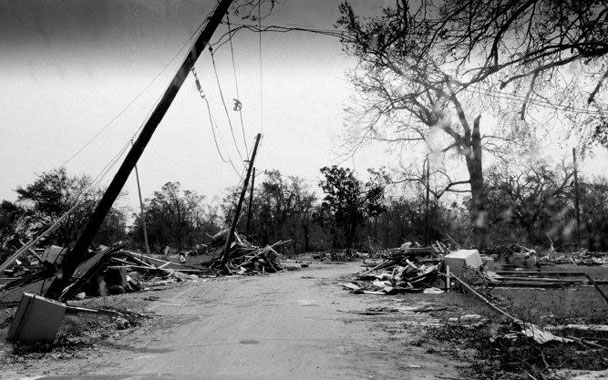I remember it being quiet, incredibly quiet, the first time I ever took a walk in Mississippi. It was four or five days after I’d gotten there, six months after the storm, which is what people on the Gulf Coast call Hurricane Katrina, in characteristic understatement.
There are so many stories I carry with me from my first days in Biloxi: of communities coming together in hope and faith and work, of strangers and neighbors and welcome. And, as my time there grew unexpectedly, I gathered stories of a place that grew richer and richer in my mind, a place built on canneries and shrimp nets and built by people from farther-flung places than I would ever have imagined.
But before all that, to me, there was only the destruction. Wind that made this place look, from the air, like a blue tarp sea. Water that flattened it. All through East Biloxi, you couldn’t really tell what happened. It could have been bulldozers, it could have been bombs, it could have been God himself scrubbing the earth clean. What can explain, at a glance, why houses have their roofs sitting on their foundations? Why half of a house can be missing in the middle? Why you can look at a home from the street and see a toilet in the living room and a staircase on its side? What can turn a gas station into a giant spider sitting on a nest of trash eggs? Over and over, I saw what happens when an incredible irresistible force meets shockingly movable objects, but I saw it all from the weird remove of a car.
So one day I parked it and went on foot for a few blocks. An older man was also taking a stroll. We stopped to talk. Pointing across the street, he told me about the old five-and-dime store he remembers, and next to it, the old Woolworth’s. This used to be a bustling street, the main retail artery of the Biloxi he grew up in. “They closed everything down to revitalize the place,” he said. “All the stores moved out while they worked on it, and by they time they reopened, everyone had already started driving out to the Walmart by the highway to do their shopping. It’s never been the same since. I wish they’d change it back to the old way when they rebuild the city, but I don’t know if that would make it the way it was.”
He talked about the Barqs family, how the root beer that bears their name was invented here, how they sold all their bottling plants years ago, how they sold their secret formula to Coca-Cola. He talked about how one of the Barqs girls ran up to him, kissed him, and hugged him when she saw him after the storm. He said that several times, about the Barqs girl. We talked for a few more minutes, he thanked me for coming to help, and we left, the only two people in sight.
I turned south towards the water and soon came upon a stunning home. It was a simple structure made of brick with solid walls and strong, definite angles, but its entire frontage was behind a gorgeous green wrought-iron gate, the metal twisted in an intricate pattern that brought to mind my imagination of New Orleans, an imagination created by scenes from steamy movies and A Confederacy of Dunces. It was for sale.
Next door was Mary Mahoney’s Old French House restaurant, which was one of the first businesses to reopen, and one of four places where you could trade money for food. I read its menu, heavy with old Creole dishes: crabmeat-stuffed everything, trout amandine, bread pudding. Later I would meet the chef, Georgo Trojanovich, learning through him about Biloxi’s deep Croatian heritage, meeting men with names like Corky and Fo-Fo and having an open invitation to dinner at their lodge house.
But for the moment, what Mary Mahoney’s was to me was a building that survived, unlike the one across the path with broken beams fanned out like a fish fins.
A sign strikes me: “MM’s Sidewalk Café - po-boys, beignets, open 24 hours.” The café was nothing more than two locked doors, but in the hot sun, the sign made me see something else: Steaming summer nights, 2 A.M., wrought-iron tables that match that gating a house away. A bit of earthy coffee mixed with chicory, and a puff or two of fried dough to go with it. Talk and whiskey, red lights, drugs around the corner. People in the building above having sex to take their minds off the heat. This is what that sign made me see, images translated from clichés, and a one-dimensional imagination of a place that, for me, was going to change.
A few months ago, I had a post here on Mr. Leroy Duvall and the Biloxi French Club. That was a story I came across while gathering oral history interviews with Biloxians about the shrimping industry, exploring the ethnic communities of this place. Soon, that interview project will go live on the Southern Foodways Alliance website, and I hope you’ll listen to some of these lovely people talk over there. And here, I’ll be posting more stories of how I came to meet them, and how they taught me about the richness of this place.


